Last updated: February 9, 2024
Article
Floyd Bennett Field: Naval Aviation's Home in Brooklyn (Teaching with Historic Places)
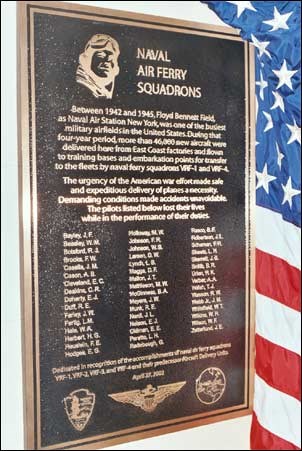
(Floyd Bennett Field Task Force)
This lesson is part of the National Park Service’s Teaching with Historic Places (TwHP) program.
Talking along Floyd Bennett Field's historic hanger row today you can almost hear the roar of the mighty engines that powered aircraft on their way to patrol the vital sea lanes of the Atlantic during the German U-Boat offensive of 1942. Look into Hanger B and imagine the ground crews receiving newly built planes from companies like Grumman, Vought-Sikorsky, and General Motors, testing them, and then commissioning some 46,000 aircraft. Imagine the Air Ferry Squadron One (VRF-1)¹ pilots soaring off to deliver Wildcats, Hellcats, and Avengers to Navy and Marine aviation units on their way to fight in the major battles of the Pacific during World War II.
Floyd Bennett Field's heritage in both civil aviation and military aviation is long and rich. However, its greatest impact on United States history took place during World War II when the "Janes who made the planes" and the men who tested and delivered the aircraft made Naval Air Station New York (Floyd Bennett Field) the busiest naval air station in the nation. By reducing the processing time for aircraft from 10 days (1941) to three days (1943) they insured that the huge number of aircraft flowing off the assembly lines reached U.S. and Allied forces.
Located in Brooklyn, NY, today Floyd Bennett Field is preserved by the National Park Service as part of Gateway National Recreation Area. Although it lacks the bustle of the past, it is not silent. In Hangar B, volunteers contribute thousands of hours annually restoring vintage aircraft that once flew from the field. Visitors tour the airfield learning its proud story: its defense of the nation during World War II as it guarded ships leaving New York Harbor, as well as its role in one of the greatest industrial feats of all time, giving wings to the armed forces of the United States.
About This Lesson
This lesson is based on the National Register of Historic Places registration file, “Floyd Bennett Field Historic District,” materials in the files of the VRF-1 Association and the Floyd Bennett Field Task Force, as well as published sources related to the history of Naval Air Station New York (Floyd Bennett Field) and the Grumman Corporation's aircraft production in World War II. Richard Reed and James Van Westering of the Floyd Bennett Field Task Force wrote Floyd Bennett Field: Naval Aviation's Home in Brooklyn with assistance from the staff of Gateway National Recreation Area, National Park Service. Education consultant, Jean West, and the Teaching with Historic Places staff edited the lesson.
*Special note to teachers:
While the official naval designation for the air base was Naval Air Station New York during the period from 1941 to 1972, informally the base was always also referred to as Floyd Bennett Field. The name "Floyd Bennett Field" never went out of general widespread use.
Where it fits into the curriculum
Topics: This lesson could be used with units on World War II, Women's History, or units on measurement in mathematics.
Time Period: Mid-20th century
United States History Standards for Grades 5-12
Floyd Bennett Field: Naval Aviation's Home in Brooklyn relates to the following National Standards for History:
Era 8: The Great Depression and World War II (1929-1945)
-
Standard 3B- The student understands World War II and how the Allies prevailed.
-
Standard 3C– The student understands the effects of World War II at home.
Curriculum Standards for Social Studies
(National Council for the Social Studies)
Floyd Bennett Field: Naval Aviation's Home in Brooklyn relates to the following Social Studies Standards:
Theme II: Time, Continuity and Change
-
Standard C - The student identifies and describes selected historical periods and patterns of change within and across cultures, such as the rise of civilizations, the development of transportation systems, the growth and breakdown of colonial systems, and others.
-
Standard D - The student identifies and uses processes important to reconstructing and reinterpreting the past, such as using a variety of sources, providing, validating, and weighing evidence for claims, checking credibility of sources, and searching for causality.
Theme III: People, Places and Environments
-
Standard A - The student elaborates mental maps of locales, regions, and the world that demonstrate understanding of relative location, direction, size, and shape.
-
Standard D - The student estimates distance, calculates scale, and distinguishes other geographic relationships such as population density and spacial distribution patterns.
Theme IV: Individual Development & Identity
-
Standard C - The student describes the ways family, gender, ethnicity, nationality, and institutional affiliations contribute to personal identity.
-
Standard F - The student identifies and describes the influence of perception, attitudes, values, and beliefs on personal identity.
Theme VI: Power, Authority, & Governance
-
Standard D - The student describes the ways nations and organizations respond to forces of unity and diversity affecting order and security.
-
Standard F - The student explains conditions, actions, and motivations that contribute to conflict and cooperation with and among nations.
-
Standard G - The student describes and analyzes the role of technology in communications, transportation, information-processing, weapons development, or other areas as it contributes to or helps resolve conflicts.
Theme VII: Production, Distribution, & Consumption
-
Standard B - The student describes the role that supply and demand, prices, incentives, and profits play in determining what is produced and distributed in a competitive market system.
Theme VIII: Science, Technology, and Society
-
Standard A - The student examines and describes the influence of culture on scientific and technological choices and advancement, such as in transportation, medicine, and warfare.
Floyd Bennett Field: Naval Aviation's Home in Brooklyn relates to the following Standards for School Mathematics developed by the National Council of Teachers of Mathematics:
Measurement
Instructional programs from prekindergarten through grade 12 should enable all students to--
-
understand measurable attributes of objects and the units, systems, and processes of measurement;
-
apply appropriate techniques, tools, and formulas to determine measurements
Objectives for students
1) To understand the importance of the role of the United States as the “Arsenal of Democracy” to the outcome of World War II.
2) To illustrate how the collaboration between private enterprise in war equipment production, and the military's Naval Air Ferry Command in delivery, succeeded in the deployment of approximately 100,000 critically-needed new aircraft to the front lines.
3) To outline the contributions on the home front of women aircraft workers, such as the “Janes who made the planes” for Grumman Corporation, to Allied victory in World War II.
4) Research how WWII has been commemorated in their community or plan a program to commemorate Veterans Day or Memorial Day in their community.
Materials for students
The materials listed below can be used directly on the computer or can be printed out, photocopied, and distributed to students.
1) Four Maps including a Floyd Bennett Field Historic District map, a regional map showing the Field's relationship to World War II aircraft factories, and national maps showing naval air ferry routes, stopover and terminal sites;
2) Three readings about Floyd Bennett Field, including its role in the Battle of the Atlantic, the story of Grumman Corporation's woman aircraft workers who built planes delivered to Floyd Bennett Field, and the Naval Air Ferry Command's role in delivering newly-commissioned airplanes to combat-bound units in World War II;
3) Eight photos of Floyd Bennett Field and the men and women whose efforts made it so successful during World War II.
Visiting the site
The Floyd Bennett Field Historic District is located on Floyd Bennett Field, which is part of the Jamaica Bay Unit of Gateway National Recreation Area. The district is located at the southern base of Flatbush Avenue, Brooklyn, New York. Take the Belt Parkway to exit 11-S (Flatbush Avenue South). Make a left at the last light before the toll plaza for the Marine Parkway Bridge into Floyd Bennett Field. Floyd Bennett Field is open daily from sunrise to sunset. The Ryan Visitor Center is open from 9:00 a.m. to 5:00 p.m. daily, except for Thanksgiving and Christmas. For further information, please write to Gateway National Recreation Area, Public Affairs Office, 210 New York Ave., Staten Island, NY 10305, call the park's Visitor Center staff at (718) 338-3799, or visit the park's website.
Getting Started
Inquiry Question
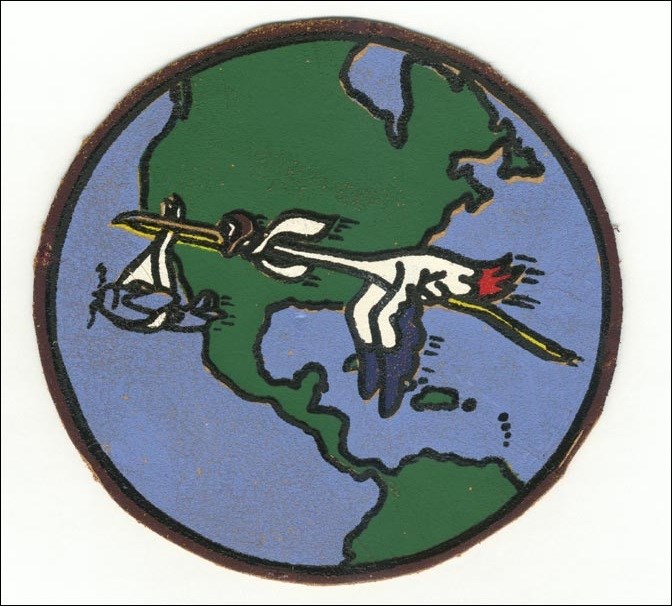
(Courtesy of VRF-1 Association)
Setting the Stage
New York City's first municipal airport, Floyd Bennett Field, opened May 23, 1931. Located on a site called Barren Island, the airfield's importance was reflected at its dedication by the presence of aviation pioneers. Included in the list of attendees were Charles Lindbergh (who had flown non-stop from Roosevelt Field, New York to Le Bourget Field in Paris, France in 1927) and James “Jimmie” Doolittle (military aviator in both World War I and World War II, aviation speed trophy holder, and dare-devil who first performed an outside loop). Admiral Richard E. Byrd (the polar explorer who flew over the North Pole in 1926 and the South Pole in 1929) also attended the dedication. The airport was named for Floyd Bennett, the pilot for Byrd's North Pole overflight and recipient of the Congressional Medal of Honor.
In 1931, Floyd Bennett Field was one of the most advanced airports in the world. From the Field, throughout the 1930s, early aviators attempted or completed numerous pioneering transcontinental, transatlantic, and round-the-world flights and established speed records with both passenger and transport planes. Laura H. Ingalls and Jacqueline Cochran set transcontinental speed records for women; Howard Hughes set intercity and round-the-world flight records on his way to becoming one of the wealthiest and most reclusive men in America; and Douglas “Wrong-Way” Corrigan achieved notoriety by filing a flight plan for California, but ending up in Ireland.
Floyd Bennett Field may have been famous, but its failure to win U.S. air mail contracts meant that passenger airlines (which needed postal income to be profitable) refused to schedule flights into the airfield. In 1939, with the opening of the city's second municipal airport, LaGuardia Airport, city officials put Floyd Bennett Field up for sale. The U.S. Navy wanted to improve its aviation capability around the port city of New York and already had a Naval Air Reserve Squadron located at Floyd Bennett Field. The Navy acquired the airfield on June 2, 1941 and it was officially commissioned as U.S. Naval Air Station, Brooklyn, New York. However, it continued to be commonly referred to by its civilian name, Floyd Bennett Field.
The Neutrality Acts, passed by Congress during the 1930's, obligated President Franklin D. Roosevelt, upon the outbreak of hostilities between two or more foreign countries, to proclaim formally that a state of war existed. This made unlawful for the United States to export arms, ammunition, or the implements of war to those hostile nations. In general, the Neutrality Acts reflected the attitude of an American public that did not want to be drawn into a war in Europe. When Germany invaded Poland on September 1, 1939, World War II began in Europe. The major nations of Europe and Asia became divided into two camps: the Axis (Germany, Italy and Japan) and the Allies (England, France, China and later the Soviet Union). Americans had already begun to heed President Roosevelt's call in December, 1940, that the United States “must become the great arsenal of democracy.” During 1940 and 1941 the United States started to increase its military preparedness. In March 1941, Roosevelt persuaded Congress to pass the Lend-Lease Act allowing the U.S. to lend the Allies war materiel in return for repayment after the war. However, until the Japanese attack on the U.S. naval fleet at Pearl Harbor, Hawaii, on December 7, 1941, U.S. public opinion remained divided on the issue of direct American military involvement in the war.
The last civilian flight out of Floyd Bennett Field took off on May 26, 1941. The United States was still neutral despite the outbreak of war in Europe in September 1939. Yet, from the beginning of 1941, with German U-Boat submarines prowling the Atlantic, “Neutrality Patrols” (which flew as escorts to convoys shuttling war materiel to Great Britain from New York) were equipped with depth bombs.¹ Floyd Bennett Field was about to be plunged into war.
¹ Naval Air Station New York [Floyd Bennett Field] performed a vital function during the U-Boat offensive of 1942 by providing air cover for convoys embarking from the Port of New York. The Naval Ferry Squadron based there delivered thousands of aircraft to the fleet from factories on Long Island.
Locating the Site
Map 1: Aerial Photograph of Floyd Bennett Field Historic District, 1980.

NPS photo
The Floyd Bennett Field Historic District, located in southeastern Brooklyn, New York, within the Jamaica Bay Unit of Gateway National Recreation Area, has remained virtually unchanged in appearance since it was constructed between 1928 and 1931. The historic district includes the Administration Building with its distinctive control tower (now the Ryan Visitor Center), eight original hangers, the central runway system, and several dependent buildings. It was listed on the National Register of Historic Places in 1980.
Planners and the workers of the New York City Department of Docks made great efforts to insure that the airfield was constructed in conformity to the 1928 Department of Commerce guidelines. Among the airport construction guidelines was the recommendation for buildings to be arranged in a row along one side of the runway.
Questions for Map 1
1. Using the compass located in the lower right hand corner of Map 1 answer the following questions:
- In relation to the runways, in what direction are the buildings located?
- In what directions are two of the runways laid out?
2. Using the scale in the bottom right hand corner of the map, answer the following questions:
- What is the distance from the Transformer Building to the Garage/Maintenance Building?
- What is the length of the North-South runway?
3. How was the construction of Floyd Bennett Field conforming with the 1928 Department of Commerce regulations on building layout?
4. How might the runways and unobstructed approach over water make Floyd Bennett Field the ideal airport for pilots wishing to establish speed records?
Locating the Site
Map 2: Aircraft Manufacturers Supplying Floyd Bennett Field, 2003.
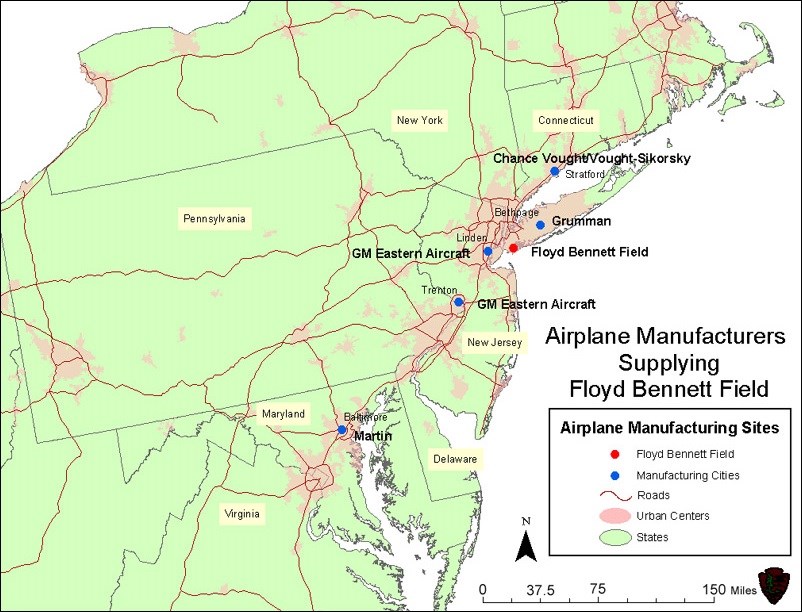
(National Park Service)
The largest manufacturers of naval aircraft on the East Coast were Grumman, Vought-Sikorsky¹, General Motors (GM Eastern Aircraft Division) and Martin. They built nearly every type of aircraft used by the U.S. Navy including carrier-borne fighters, bombers and patrol planes. Floyd Bennett Field became the operational hub for air ferry operations for these manufacturers as well as the command center for all naval air ferry operations in the United States. Ferry pilots were flown to the manufacturing plants where they picked up new planes and flew them to Floyd Bennett Field for testing and commissioning, and then delivered the planes to training bases and embarkation points across the country. In 1941 this process could take 10 days; by 1943 it had been reduced to 3 days insuring the expeditious delivery of aircraft. Over 46,000 new aircraft were commissioned into active service and delivered by two naval air ferry squadrons based at Floyd Bennett Field.
Questions for Map 2
1. Using the scale in the bottom right hand corner of the map, answer the following questions:
-
How many airplane manufacturers were located within 25 miles of Floyd Bennett Field? Name the companies.
-
How many additional airplane manufacturers were located within 75 miles of Floyd Bennett Field? Name the companies.
-
How many additional airplane manufacturers were located within 150 miles of Floyd Bennett Field? Name the companies. 75 miles of Floyd Bennett Field? Name the companies.
2. What are at least three advantages that urban centers and cities might have offered to airplane manufacturers?
3. Why do you think the location of Naval Air Station New York (Floyd Bennett Field) contributed to its becoming the busiest naval air station in the United States during World War II?
¹ The Vought name was associated with two divisions of the United Aircraft Corporation located at the Stratford, Connecticut aircraft plant: the Chance-Vought Division and the Vought-Sikorsky Division. Both of these divisions are shown on Map 2. These two divisions were involved with the design and manufacture of the very important and successful Navy WWII fighter, the Vought F4U Corsair. This plane is often also referred to as the Chance-Vought F4U Corsair as well as the Vought F4U Corsair.
Locating the Site
Map 3: World War II Aircraft Ferry Routes Originating from Floyd Bennett Field, 2003.
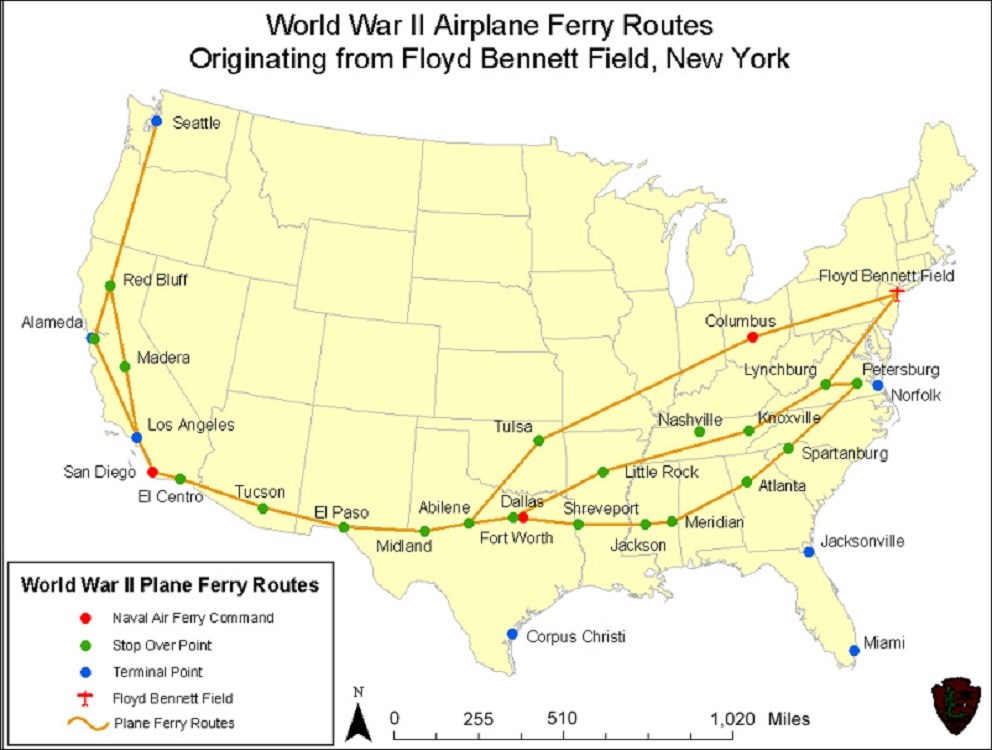
National Park Service
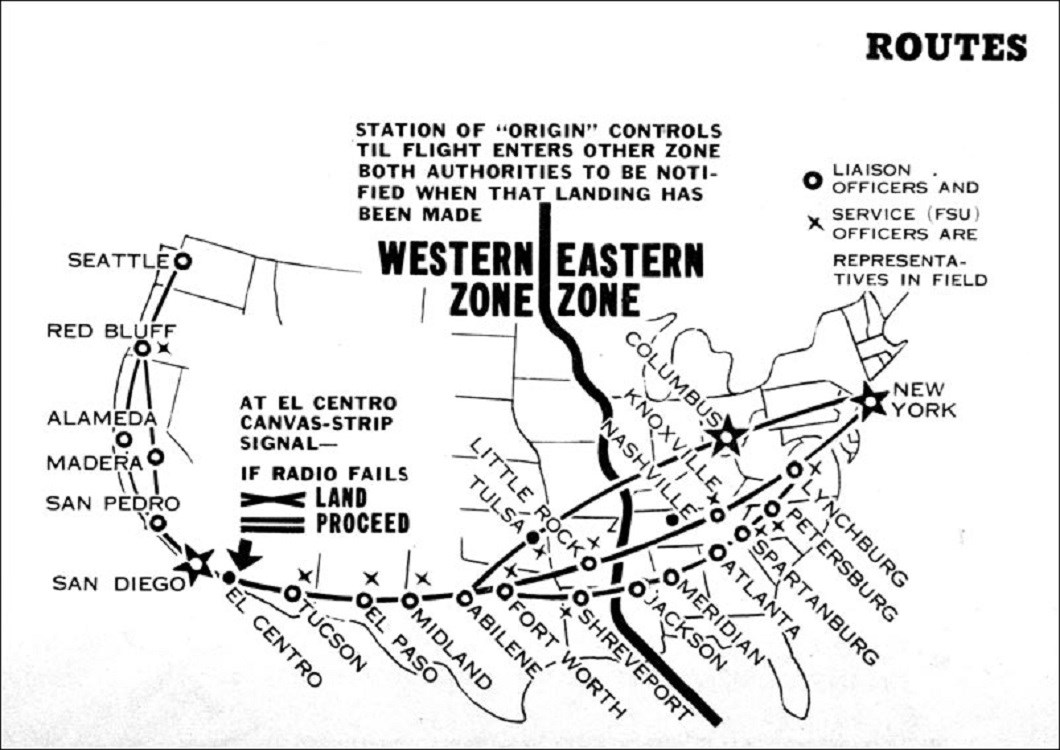
(VRF-1 Association)
Naval Air Station (NAS) New York was home to the largest naval aviation squadron ever assembled, Air Ferry Squadron One (VRF-1). On December 1, 1943, it also became headquarters of the Naval Air Ferry Command which controlled all naval air ferry operations throughout the United States. Three naval air stations were the operating bases of the Naval Air Ferry Command--NAS New York, home of VRF-1 and VRF-4, NAS Columbus (Ohio), where VRF-2 was based and NAS Terminal Island (Los Angeles, CA), home of VRF-3. Approximately 100,000 new aircraft were commissioned into active service and delivered by all naval air ferry squadrons during the war.
Major transcontinental and coastal air ferry routes were laid out allowing for frequent stops at designated airports. Ferry service units or auxiliary ferry service units were located at these stopover airports to keep planes serviced and in flying trim. For ferrying purposes the United States was divided into an eastern zone and a western zone with the Mississippi River the boundary.
The Land and Proceed graphic on Map 4 gives instructions for a pilot to follow in the event that air to ground radio communication fails or is not available. The ground-to-air back-up communication system at El Centro telling pilots to "land" or "proceed" was a large canvas-strip signal lying on the ground. The graphic on Map 4 is informing the pilot that at El Centro there will be a canvas-strip signal--and if his radio fails and he can't communicate by voice with the air field--he is to land or proceed depending upon which canvas-strip signal is out.
Map 4 is stylized to show the general ferry routes—it is not meant to be exact.
Questions for Maps 3 & 4
1. Using the scale in the bottom of Map 3, answer the following questions. Using the shortest flight route, calculate the distance a VRF-1 ferry pilot would have to fly to deliver an aircraft from Floyd Bennett Field to:
- Norfolk
- San Diego
- Alameda
2. Using the key to Map 3, answer the following questions:
- How many stopover points were located between Dallas and San Diego?
- How many stopover points were located between Los Angeles and Seattle (by way of Madera)?
- How many Naval Air Ferry Command centers were there in the United States?
3. Use the key to Map 4 to answer the following questions:
- What two options were available to pilots if the radio fails at El Centro?
- What geographical feature does the Eastern-Western Zone appear to follow?
- After leaving Tucson, bound for Seattle, in what town will a pilot first find a liaison officer?
- After leaving Tucson, bound for Seattle, in what town will a pilot first find a service officer?
Determining the Facts
Reading 1: Floyd Bennett Field--World War II 1941-1945
The United States had taken steps towards military preparedness in 1939, with the Naval Aviation Reserve Act and Civilian Pilot Training Acts which together authorized 6,000 new officers, added new training bases, and expanded pilot training to 20,000 students at 11 colleges.¹ In 1940, the Vinson-Walsh Act also authorized a 70% increase in the Navy's overall combat readiness, including naval aviation. The Navy's aircraft quota increased from 4,500 aircraft in 1939 to 15,000 by the end of 1940. Floyd Bennett Field became a base for naval patrol squadrons prior to its sale to the U.S. Navy. On June 2, 1941, the airfield was officially commissioned U.S. Naval Air Station, Brooklyn, New York with the mission “to provide base facilities for the Fleet and the North Atlantic Naval Frontier, and to assemble, service, equip, and deliver naval aircraft from factory to fleet.”²
Following the Japanese attack on Pearl Harbor, Hawaii, on December 7, 1941 and a declaration of war by Congress, Floyd Bennett Field's duties as Naval Air Station New York grew rapidly. The Navy adapted the civilian airport's Administration Building with its control tower and the permanent hangars to military service. The Navy also expanded the runways and facilities for seaplanes and built additional functional structures. Several aviation units of the Atlantic Fleet, three submarine patrols squadrons, a scout observation service unit, and two Naval Air Transport Service squadrons were based at the air station. In addition, Navy WAVES (Women Accepted for Volunteer Exceptional Service) operated radio equipment out of the control tower, directing traffic at this busiest naval air station in the nation, while others packed parachutes for use by aviators, served as aviation machinist mates, or “plane captains.”
Former WAVES interviewed on March 22, 2004 shared their recollections. Fran (Boggs) Metcalf recalled, “I carried lots of tools, washed props down, changed oil filters, unbuckled cowling and dusted cockpits. I worked on F4Us, F4Fs and PBYs.”³ In addition to their regular jobs, WAVES served on desk duty over the weekends. Amy May (Foster) Feluk detailed their schedule: “WAVES were on duty on a four-day duty schedule. One weekend we were off on Saturday, one weekend we were off on Sunday, one weekend we were off on Saturday and Sunday, and one weekend we were on duty all weekend.” Josephine (Camerlengo) Tanner was assigned to the Aircraft Commissioning Unit (ACU) and explained, “This unit handled the receipt, equipping and checking naval aircraft arriving from the Grumman and eastern factories…I was transferred from ACU to Assembly & Repair (A&R). This department was responsible for having every aircraft properly assembled and kept in satisfactory flying condition, as well as overhauling engines on a regular basis. It was in this department that I was plane captain to a crew of three men. My signature was on the paper that released the serviced aircraft for ferrying to the West Coast.”
The site was also home to a Coast Guard station, where the newly developed Sikorsky R-4 helicopter was tested and in early 1944 first employed on a rescue mission. Naval Air Station New York administered two auxiliary airfields, as well. Naval Air Facility (NAF) Roosevelt Field (Mineola, Long Island, New York) served as a center to modify airplanes for use by the Royal Navy, while NAF Mercer Field (Trenton, New Jersey) received Grumman-designed combat planes from an adjacent General Motors plant which had converted its assembly line from automobile production to the production of aircraft for the war effort.
Some of the people who worked at Naval Air Station New York lived on the base while others lived in nearby communities and commuted to work by subway and then bus or rideshare. The base theater hosted top New York entertainers and celebrities such as impresario Ed Sullivan, while its Officer's Club was decorated with luxurious Art Deco materials salvaged from the sunken ocean liner Normandie. Sports leagues, such as the Floyd Bennett baseball team, offered off-duty relaxation to sailors posted at this Brooklyn location.
For all the attractions of civilian life associated with being in vibrant New York City, the personnel at Naval Air Station New York were entrusted with a serious job. With the entry of the United States into the war on the side of the Allies in December, 1941, Germany immediately began waging unrestricted submarine warfare against the U.S. merchant fleet. These ships, carrying both troops and war materiel, were targeted not only on the high seas, but also within sight of the Atlantic coastline. Naval Air Station New York expanded its anti-submarine patrols. Only a few months into the war, on May 1, 1942, the U.S. Navy's Eastern Sea Frontier war diary records a Navy plane attacking a periscope sighted near Fire Island, off the southern coast of Long Island, New York. An even more serious engagement occurred on August 7, 1943 when a patrol aircraft based at Floyd Bennett Field located and attacked a U-Boat, but was shot down. Throughout the war, aviators on patrol developed and tested inventions and improvements in anti-submarine warfare. Their contributions during the “Battle of the Atlantic” helped secure the trans-Atlantic supply line by the end of 1943. The reliable source of men and materiel enabled the Allies to mount the invasion of Normandy on D-Day, June 6, 1944.
Questions for Reading 1
1. How significant do you think the naval air patrols from Naval Air Station New York (Floyd Bennett Field) were during World War II? In forming your answer, consider the following issues:
-
What intelligence information could undetected German submarines in the waters off of New York have collected that would have harmed the Allied war effort?
-
What strategic advantages could German attacks on shipping entering and departing New York Harbor and Long Island Sound have given the Axis powers (Germany, Italy, and Japan)?
-
What advantages could German attacks on shipping in the New York area have provided the Axis in terms of the morale of U.S. civilians?
2. Who were the U.S. Navy WAVES? What types of jobs were performed at Naval Air Station New York by U.S. Navy WAVES? How do you think the substitution of women for men in the performance of these jobs helped the U.S. war effort?
3. Personnel at the Naval Air Station New York , like U.S. civilians, coped with wartime rationing. What evidence do you find in Reading 1 suggesting how people stationed off-base managed to commute despite the rationing of gasoline?
Reading 1 was compiled from the National Park Service's brochure Floyd Bennett Field: WWII 1941-1945; NAS BEAM: U.S. Naval Air Station New York, Floyd Bennett Field (Baton Rouge, LA: Army and Navy Publishing Co., 1944) ; Metcalf, Fran Boggs; Amy May Foster Feluk; and Josephine Camerlengo Tanner. “Memories of the service careers of three Navy W.A.V.E.S.” 22 March 2004, Floyd Bennett Field Task Force Collection, Brooklyn, New York ; Eastern Sea Frontier War Diary, Defenses of the Southern New York Harbor, December 1941-September 1943, National Archives and Records Administration (available on microfilm from the Naval Historic Research Center, Washington Navy Yard, Washington, DC, microfilm NRS 1971-48); U.S. Congress. Senate. Committee on Naval Affairs. The Decline and Renaissance of the Navy 1922-1944. Report prepared by Senator David I. Walsh, Senate Document 202, 78 th Cong., 2d. sess., 1944; and materials in the collection of the Floyd Bennett Field Task Force.
¹ One beneficiary was Tuskegee Institute which trained African-American aviators, the Tuskegee Airman, who saw service in World War II.
² NAS Beam: U.S. Naval Air Station New York Floyd Bennett Field (Baton Rouge, LA: Army and Navy Publishing Co., 1944). At NAS New York, combat air patrol operations were conducted in support of the mission to provide base facilities for the North Atlantic Naval Frontier and air ferry operations were conducted in support of the mission “to assemble, service, equip, and deliver naval aircraft from factory to Fleet.”
³ F4U--Chance-Vought Corsair Fighter, F4F--Grumman Wildcat Fighter, and PBY--Consolidated Catalina Patrol Plane.
Determining the Facts
Reading 2: The Janes Who Built the Planes
If enough fighters and torpedo bombers are to reach our boys in the Pacific and European fronts, their wives and mothers, sisters and sweethearts, are going to have to help build them.¹
-- Port Jefferson Times, May 28, 1943
One of the aircraft production plants situated close to Naval Air Station New York (Floyd Bennett Field) was Grumman Aircraft Engineering Corporation Plant No. 1 located on Long Island in Bethpage, New York. Founded in 1930, Grumman produced around 40 planes annually until 1940. As the United States began its conversion to the “Arsenal of Democracy,” Grumman’s production rose to 40 planes a month. However, with the U.S. entry into World War II late in 1941, millions of men joined the United States armed forces and Grumman, like all companies, faced labor shortages. Beginning in March 1942, Grumman hired women to work in aircraft production. In less than two years, the number of female employees of Grumman’s War Productions Corps would rise from the initial six women aircrafters to 8,000, just under a third of Grumman’s wartime work force. During the course of the war, Grumman workers assembled 17,000 airplanes for the U.S. Navy (including a record 664 in the month of March 1945), while military personnel from Floyd Bennett Field processed finished Grumman aircraft – Avengers, Hellcats, and Wildcats – into service. This achievement would not have been possible without the contributions of the civilian women workers of the home front who were immortalized in popular songs of the era including “We’re the Janes Who Make the Planes,” “The Lady from Lockheed,” and the most famous, “Rosie the Riveter.”
Because women had been considered unsuited for aviation production work prior to World War II, they lacked basic skills necessary to aircraft construction. Grumman instituted 10 week aviation construction training courses that introduced newly hired women to reading blue-prints, riveting and assembly skills. Once they were on the job, Grumman learned that the women’s typical smaller size and dexterity had advantages. In a 1943 edition of Grumman’s in-house employee newspaper, Plane News, the head of the Electrical Department, John Porter, helped to explain why 52 of his 54 employees were women, stating that “the girls learn quickly and in many instances are much more capable than men in assembling delicate parts.”
Grumman employed women in other capacities besides the assembly line. It was the first company to hire women test pilots. Elizabeth Hooker, Barbara Jayne, and “Teddy” Kenyon tested military aircraft for reliability and safety, although they were barred from testing experimental aircraft or planes suspected of having serious defects. College graduates could work as apprentice engineers, following intense preparation in calculus, drafting, aerodynamics and mechanics. They assisted male engineers in designing aircraft.
Grumman attracted women workers ranging from recent high school graduates to women in their sixties. The average age of women working at Grumman was 36; for the first time many women workers were married with children. (Also, for the first time, Grumman hired African-American men and women, approximately 800.) Women were attracted to Grumman out of patriotic duty and also because unskilled women workers earned only .25 cents an hour while Grumman’s semi-skilled workers earned $1.00 an hour. Grumman gave preference to hiring workers who lived locally, so women did not have to relocate in an already tight, price-controlled housing market to work at the company. Working in their home community of Bethpage also helped women to live within their gasoline rations and allowed them to turn to relatives and neighbors for child care and other support. Grumman management instituted a number of innovations to fight absenteeism and turnover of its women employees including job counselors, cafeterias, exercise breaks, recreational sports and social programs, an annual Christmas turkey and sponsorship of three “war-time nurseries” for children between the ages of two and five.
By the end of 1945, peace arrived and signaled the end of the “glory days” of the woman aircraft workers, Floyd Bennett Field, and ultimately Grumman itself. The day after V-J (Victory in Japan) Day in 1945, facing the loss of its government contracts, Grumman laid off all of its employees. It rehired on the basis of seniority and proficiency; in 1947 only three women of the thousands who had worked on Grumman’s production line during the war remained. Naval Air Station New York continued to play an important military role after the war. It served 30 Navy and Marine squadrons and became one of the nation’s largest air reserve training bases through the Cold War and conflicts in Korea and Vietnam. However, ferry command was transferred to Norfolk, Virginia, in 1946. In 1971, the base was deactivated, and Floyd Bennett Field was incorporated into the National Park Service’s Gateway National Recreation Area the following year. Grumman’s Navy contracts, notably for the F-14, and work on the Apollo Lunar module sustained the company through the Cold War. In 1994, due to the fall of the Soviet Union and cutbacks in defense spending, Northrop Corporation of Los Angeles, California acquired Grumman and significantly reduced operations on Long Island.
The events that occurred at Naval Air Station New York and Bethpage from 1941 to 1945 contributed significantly to Allied victory in World War II. Joshua Stoff, the first curator at the Cradle of Aviation Museum in Garden City, New York, summed up the importance of aircraft production saying, “One of the greatest industrial feats of all time was the massive production of aircraft by American industrial manufacturers during World War II. In many ways, the Allied victory hinged on this huge American industrial contribution. This achievement also resulted in several new developments in American industry: (1) The true mass production of military aircraft, a phenomenon never seen before or since. (2) The unprecedented introduction of women and minorities into the skilled workforce. (3) The greatest period of camaraderie and high morale among workers ever.” ²
Questions for Reading 2
1. Why did Grumman begin to hire women aircraft workers in 1942? What types of jobs did they perform for the company?
2.What characteristics helped change the perception that females were unsuited for aviation production work?
3.What benefits did Grumman offer to attract women workers?
4. How did peace impact Naval Air Station New York (Floyd Bennett Field), the women workers of Grumman and Grumman Corporation itself?
5. How did American industry help facilitate the Allied victory in WWII? What new developments in American industry resulted from its participation in the war effort?
Reading 2 was compiled from the National Park Service's brochure Floyd Bennett Field: WWII 1941-1945; Christine Kleinegger, The Janes Who Made the Planes: Grumman in World War II. The Long Island Historical Journal (Fall 1999, Vol. 12:1); Frank N. Schubert, Mobilization (U.S. Army Center for Military History, 1995, CMH Pub 72-32); Joshua Stoff, Picture History of World War II American Aircraft Production (New York: Dover Publications, 1993); and materials in the collection of the Floyd Bennett Field Task Force.
¹Grumman Plant is Seeking Workers. Port Jefferson Times. May 28, 1943.
²Joshua Stoff. Picture History of World War II American Aircraft Production (New York: Dover Publications, 1933), ix.
Determining the Facts
Reading 3: Aircraft Delivery Unit and Naval Air Ferry Command Deliver the Planes
Naval Air Station New York (Floyd Bennett Field) was at the heart of the stunning transformation of U.S. industry from production of civilian automobiles and planes to unprecedented mass production of high-performance military aircraft. Navy personnel flew planes from nearby factories to the naval air station, tested them for flight-worthiness, fitted them out for service, commissioned them into the U.S. Navy, and finally ferried them out, typically to the West Coast, for service in Navy and Marine Corps units bound for fighting in the Pacific theater of war. Floyd Bennett Field became the busiest naval air station in the United States during World War II. Personnel worked tirelessly to make certain that the airfield functioned as an efficient hub rather than a bottleneck.
Prior to 1941, manufacturers of airplanes destined for service in the U.S. Navy tested the planes themselves. Former Floyd Bennett Field pilot Giles Gianelloni explained that fleet pilots were sent directly from their carrier or home base to the factory to fly the new aircraft back to their ship or base. When Floyd Bennett Field became a naval air station, instructor pilots would split their time between ground and air training during the mornings and in the afternoons flying newly-built aircraft from the factories back to the station until dark. The planes would be placed in Navy hangers until pilots from the fleet came to fly them away.
By October 1941, aircraft production had risen to such a level that these procedures were no longer effective, so in response the Navy organized specialized Aircraft Delivery Units (ADUs) near aircraft manufacturers.¹ Hangar 6 at Floyd Bennett Field was home to one of the ADUs; between October 1941 and November 1943 it commissioned 20,000 aircraft and logged 5.6 million air miles in ferry service. Nonetheless, toward the end of 1943, it became obvious that as ever larger numbers of aircraft rolled off the assembly lines the job of the ADUs was getting much too large to be a responsibility of individual air stations. The decision was made to put all naval ferry activities throughout the country under one command.
On December 1, 1943, the U.S. Navy established the Naval Air Ferry Command under the Naval Air Transport Service, and located its headquarters at Floyd Bennett Field (NAS New York ). For the next two years, the Naval Air Ferry Command at Floyd Bennett Field developed the ever-increasing naval air ferry operations nationwide into a smooth functioning part of the war effort. The existing functions of the New York ADU were transferred to a newly-formed Air Ferry Squadron One (VRF-1) and a new Aircraft Commissioning Unit. Under the control of the Naval Air Ferry Command, three operating bases were designated: NAS New York, home to VRF-1 and VRF-4; NAF Columbus (Ohio), where VRF-2 was based; and NAS Terminal Island (Los Angeles, CA), home to VRF-3. At Floyd Bennett Field, VRF-1 grew quickly to become the largest naval aviation squadron ever assembled. In March 1944, 1049 pilots were assigned to VRF-1, which was based in Hangars 9 and 10. A squadron of seaplane specialists, VRF-4, was formed and operated from Hangar B. During World War II a total of 100,000 new aircraft were commissioned into service and delivered to training bases and embarkation points by the combined efforts of all naval air ferry delivery units and squadrons.
From Floyd Bennett Field, ferry pilots flew to the aircraft factories in transport planes, picked up the newly-built planes, and flew them to the Field. After the aircraft were tested, accepted and commissioned at Floyd Bennett Field, ferry pilots delivered the majority of these newly-built aircraft to the West Coast. Normally, transcontinental flights were composed of three planes in V-formation. The main transcontinental ferry routes were laid out so that there would be airports or airfields where the planes could stop; these fields included ferry service units that specialized in providing ground support for the aircraft being ferried. The ferry pilots returned to the East Coast either on commercial flights or by flying battle-worn planes or new planes produced on the West Coast.
In order to track the whereabouts of individual pilots and aircraft, the ferry command divided the country into an eastern zone and a western zone (divided by the Mississippi River). Individual pilots were responsible for the safe and expeditious delivery of the aircraft and for keeping ferry command informed as to the progress of the flight. There were four ferry command pilot designations: follow pilots, single pilots, lead pilots and senior ferry pilots. The pilot designation as “follow, single, lead and senior ferry pilot” reflected increasing levels of experience measured in terms of ferry trips or flight hours and pilot qualification in various types of aircraft. Joseph O’Brien, VRF-1 Association President, reported that: “new pilots to the squadron had to make five cross country trips as follow pilots before qualifying as a single pilot.”² Single pilots were qualified to ferry a plane alone. Will Carroll, a former VRF-1 Association President, in his VRF-1 Squadron Official History, outlines some of the many questions that pilots and flight leaders had to keep constantly in mind while on ferry flights: “Do I know the quantity of gas and oil aboard? Do I have all necessary charts? Do I know how to operate the radio gear in this plane? Do I know the order of take off and point of rendezvous, the altitude to be flown, the preferred power settings for cruising, fuel consumption, destination for this hop, the traffic pattern at the point of intended landing, the tower frequency, the system for numbering runways, field conditions, break up, approach and taxiing procedures?”³
An article in Naval Aviation News from 1944 described 29 different types of aircraft which pilots needed to know how to fly; although individual pilots were not qualified to fly all types of planes, ferry pilots had to be familiar with multiple engines, ground procedures and plane checkouts. Pilots came from diverse backgrounds, not only commercial airline pilots, barnstormers and skywriters, but even plane salesmen and lawyers. Naval Air Station New York, maintained a “Glory Board” in the ready room listing pilots who had completed five transcontinental flights without accident (signified by gold wings) or 25 transcontinental flights (signified by the squadron’s insignia stork).
U.S. aircraft production doubled between 1942 and 1943 increasing the need for combat pilots and creating a tremendous shortage of pilots for both the Navy and the Army Air Force. Women aviators were called upon to help fill the gap. In September 1942, the first 25 members of the Women’s Auxiliary Ferrying Squadron (WAFS) were organized at the Army Air Base at Wilmington, Delaware; in 1943 it was integrated along with the Women’s Flying Training Detachment into the Women Airforce Service Pilots (WASP), headed by the same Jacqueline Cochrane who had established aviation speed records from Floyd Bennett Field. Together with their male counterparts in the Navy and Army Air Force they helped to deliver the nearly 275,000 aircraft assembled by U.S. manufacturers between the attack on Pearl Harbor in 1941 and the surrender of Japan in 1945.
The aviation war in the Pacific theatre of World War II was fought in large part by naval aviators and their aircraft. From Naval Air Station New York, VRF-1, VRF-4, and their predecessors ferried 46,000 aircraft, over 80 million air miles, between December 1941 and 1945. Notable among the aircraft tested and commissioned at Floyd Bennett Field was the Grumman F6F Hellcat, which finally bested the Mitsubishi Zero fighter, and is considered by many to be “the plane that won the war in the Pacific.” The Grumman TBF Avenger was to become an effective torpedo bomber against Japanese aircraft carriers. Marine Corps aviators flew the Vought-Sikorsky F4U Corsair using it with great success as a fighter plane and to provide close air support for ground troops. The quality and quantity of U.S. aircraft eventually helped to turn the tide of battle: at Midway and the Coral Sea; during the island hopping campaigns through the Solomon, Gilbert, Caroline, Palau, and Mariana Islands; in the Battles for the Philippine Sea and the Leyte Gulf; and through bloody battles from Guadalcanal to Iwo Jima. Naval Air Station New York, by insuring that the Navy and Marines were supplied with the fighter and bomber planes they needed, played a vital role in the victory of the United States over Japan.
Questions for Reading 3
1. The process used by the U.S. Navy to receive delivery of airplanes from manufacturers changed twice from 1941 to 1943.
-
How did the doubling of airplane production contribute to these changes?
-
How did the shortage of combat pilots contribute to these changes?
2. What types of skills did ferry pilots (whether reservists, WAFS, or naval aviators) need to safely cross the country and deliver their planes on time?
3. Why was the stork was an appropriate emblem for VRF-1 and the pilots with the safest delivery records?
4. Calculate the percentage of World War II aircraft processed through Naval Air Station—New York (Floyd Bennett Field) using 275,000 (the conservative estimate of the number of aircraft produced by U.S. manufacturers) and 46,000 (the number of aircraft processed by ADU, VRF-1 and VRF-4 at Floyd Bennett Field). What does this tell you about the importance of Floyd Bennett Field to the U.S. victory in World War II?
Reading 3 was compiled from the National Park Service's brochure Floyd Bennett Field: WWII 1941-1945; Giles Gianelloni, Interview by James Van Westering, 10 August 2004; Joseph O'Brien, Interview by James Van Westering, 15 August 2004; “Ferry Command Delivers the Airplanes,” Naval Aviation News, July 1, 1944; Will H. Carroll, Official History: Air Ferry Squadron One (VRF-1), Floyd Bennett Field, Brooklyn, New York, (VRF-1 Association, undated); numerous statistical and general references on naval aviation in World War II; and materials in the collection of the Floyd Bennett Field Task Force.
¹ Each ADU had two divisions: an Aircraft Ferrying Division (AFD) which flew new aircraft from factory to naval airfield ('in-flights') and delivered commissioned planes to their final destination ('ferry flights'); and an Aircraft Engineering Division (AED) which installed any equipment and weaponry required, ran a full check on the plane's systems and performed any necessary 'test flights'.
² Interviews in August 2004 with Joseph O'Brien and Giles Gianelloni, both of whom where VRF-1 ferry pilots, underscored the importance of the training center developed by the ferry command at NAS Willow Grove (PA). Pilots assigned to ferry duty received their ground and flight training at this facility after 1943 because the crowded traffic conditions at Floyd Bennett made training there nearly impossible.
³ Will H. Carroll, Official History: Air Ferry Squadron One (VRF-1), Floyd Bennett Field, Brooklyn, New York, (New York: VRF-1 Association, undated), 13.
Visual Evidence
Photo 1: Visitor Center at Floyd Bennett Field, control tower, 2004.
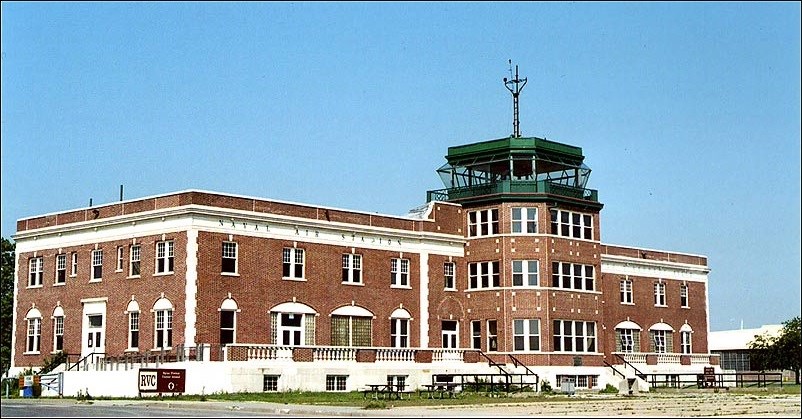
(Floyd Bennett Field Task Force)
Photo 2: WAVE operating radio equipment at the control tower, NAS- New York, 1943.
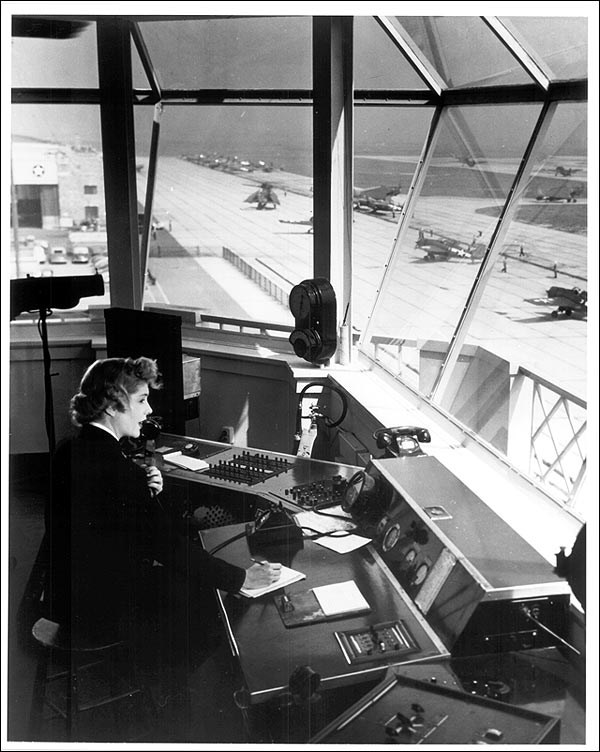
(National Archives and Records Administration)
Questions for Photos 1 and 2
1. Why do you think the control tower was constructed as part of the administration building in 1931? Does the control tower seem short or tall by modern standards? Where is the control tower at your airport?
2. Does Photo 2 give any indication of how busy the airfield was in 1943? How many planes are on the runway? What equipment that you would expect to see in a control tower is missing? Is there any other equipment that we use today that was not available to air traffic controllers in 1943? What sort of challenges might this present to an air traffic controller?
3.Why might a woman have been operating radio equipment in the control tower of NAS New York in 1943? Where might you find information for current statistics on the number of women in air traffic control today?
Visual Evidence
Photo 3: Ryan Visitor Center at Floyd Bennett Field, Stylized Globe, 2002.
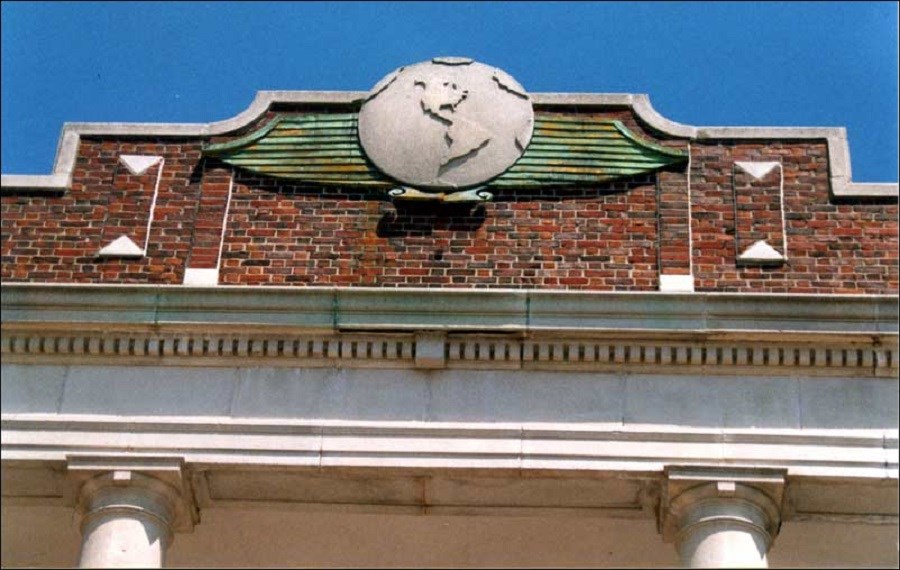
(Floyd Bennett Field Task Force)
Photo 4: VRF-1 Squadron Insignia, 1943.

(Courtesy of VRF-1 Association)
Questions for Photos 3 and 4
1. Why do you think the administration building for Floyd Bennett Field featured a globe in 1931? Why do you think the VRF-1 Squadron Insignia featured a globe in 1943?
2. How are the two emblems different? Why do you think the insignia has a close-up view of North America?
3. What does the stork traditionally represent? Why is it shown carrying an airplane rather than a baby?
4. Why do you think a ferry squadron would have used this emblem? Why do you think the stork is flying from East to West (rather than the reverse)?
Visual Evidence
Photo 5: Crew of women aircraft workers in Grumman factory, Bethpage, New York, c. 1943.
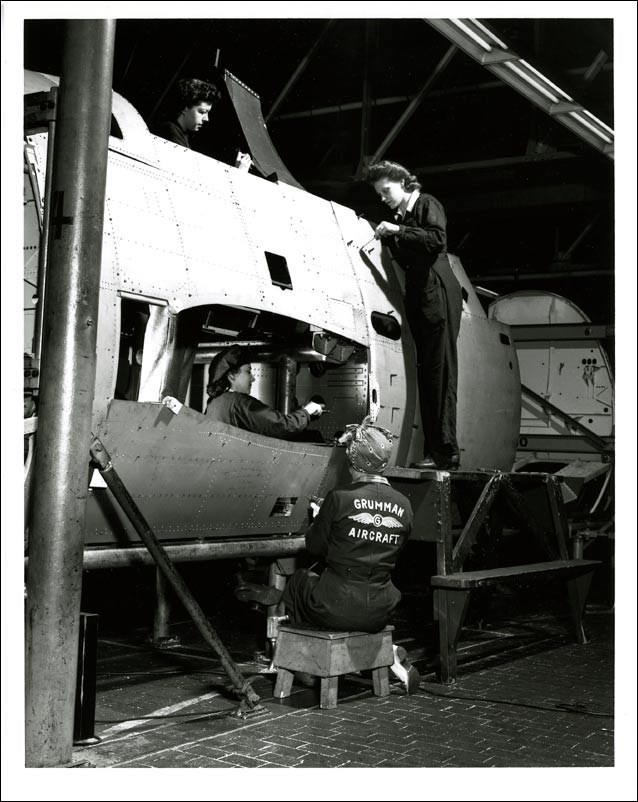
(Courtesy Northrop Grumman History Center)
Questions for Photo 5
1. How many women are working on the aircraft in Photo 5?
2. What reasons prompted Grumman to hire women to work on aircraft assembly lines during World War II?
3. What reasons might have prompted a woman to work on an aircraft assembly line during World War II?
4. What evidence is there in Photo 5 of planning and teamwork?
5. What do you think the war’s end meant in terms of employment to Grumman’s women employees? If needed, refer to Reading 2.
Visual Evidence
Photo 6: Planes and Navy personnel in front of Hanger 2, NAS New York, c. 1944.
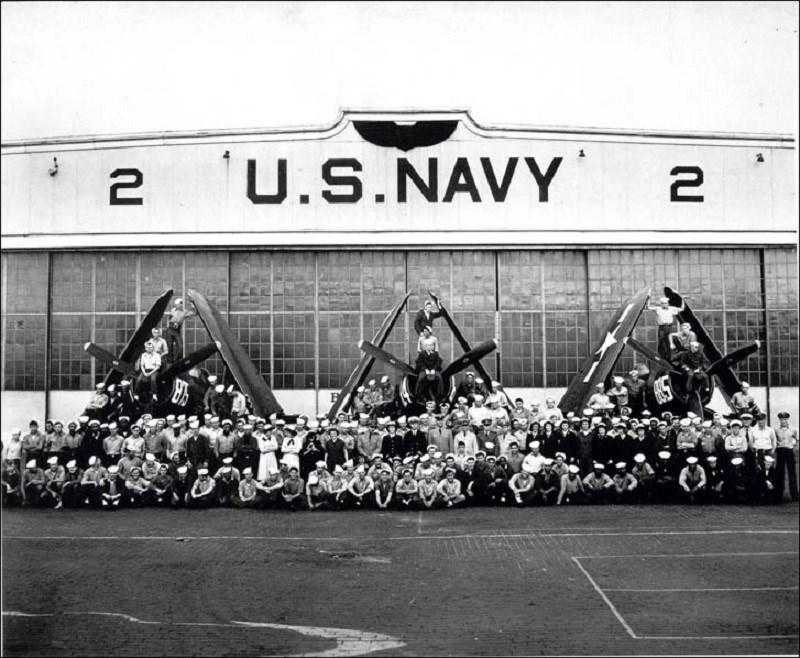
(National Park Service)
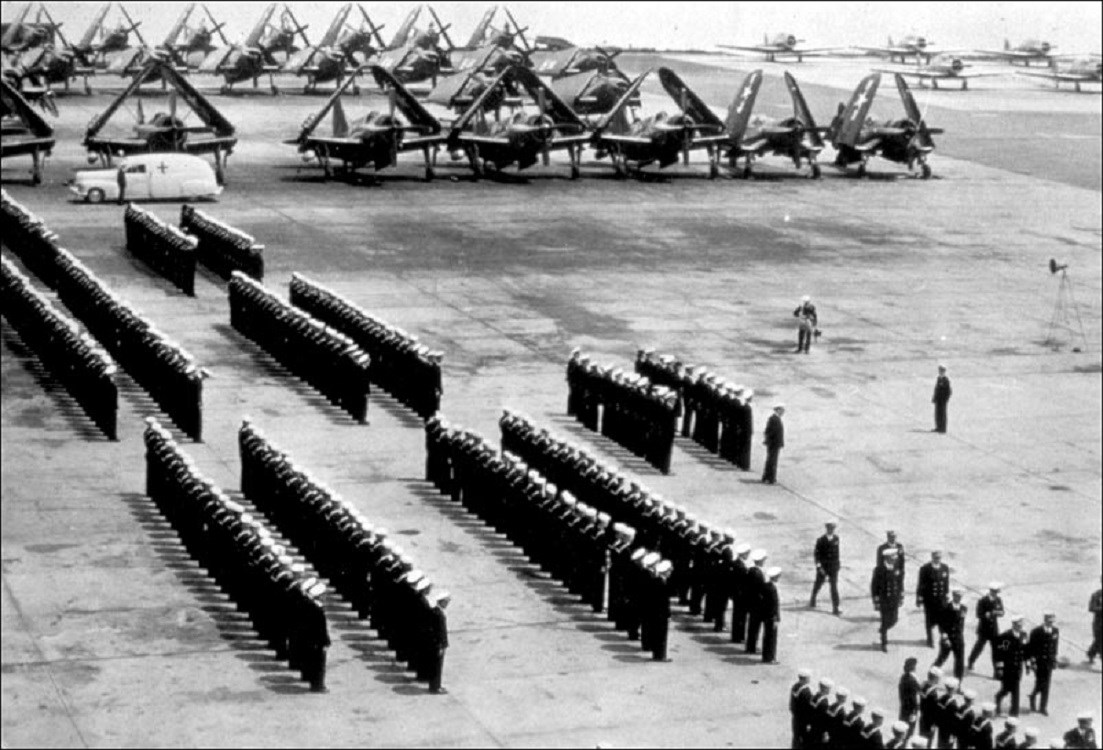
National Park Service.
Questions for Photos 6 and 7
1. Why do you think airplanes wings are folded up? Can you think of any naval equipment that this feature might be practical for?
2. Why do you think the navy personnel in Photo 6 posed for this photograph? What evidence is there of a team-effort and spirit in this photograph? What do you think the morale was like at NAS New York at the time of this photograph?
3. How do Photos 6 and 7 demonstrate the amount of work done at NAS New York? What do they suggest about the importance of NAS New York in the U.S. effort to win World War II?
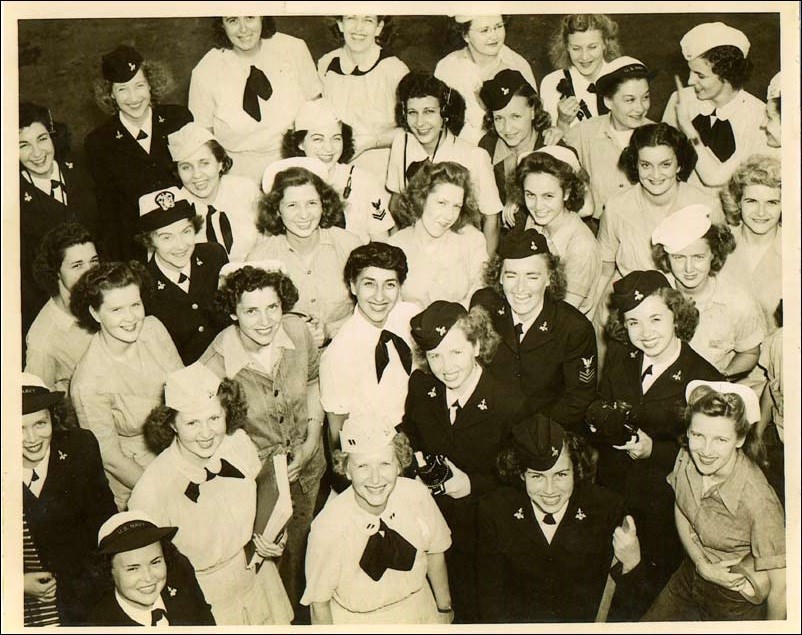
National Park Service
Questions for Photo 8
1. How many different types of uniforms are the WAVES wearing? What might account for the number of different uniforms?
2. A number of the WAVES are holding objects associated with their work including: record book, radio headset, machine gun ammunition belt, gun camera, electrical tape, navigational meter. What kind of job does each of these objects probably represent?
3. How many of these jobs do you think were traditionally women’s jobs prior to World War II? How many do you think were traditionally men’s jobs prior to World War II?
Putting It All Together: Activities
The following activities engage students in a number of ways that let them explore the impact of World War II on the people who lived through it. Students will also have an opportunity to examine the past military and home front experience of people in their community, state or region and be able to compare it with the events at Floyd Bennett Field.
Activity 1: Graphic Design
Graphic designs help people to sift through the hundreds of impressions which make up history, evaluate their relative importance, and present main ideas in a dramatic way.
-
The VRF-1 Stork Insignia was used between 1943 and 1945. Ask students to review the history of Floyd Bennett Field and either A) design a different insignia that would reflect the airfield’s history 1941-1942 or B) design a patch to honor the civilian assembly line workers who constructed the aircraft that were processed at Floyd Bennett Field. Student designs may be by hand, computer-generated, or in textiles. Students who are interested in unit patches, service ribbons, or military medals may wish to conduct further research, perhaps preparing a display of unit patches reflecting troops stationed in their community or region during World War II or the service of veterans in their community today. Have students share their displays with your class and explain the symbolism of their design.
-
Floyd Bennett Field, as well as other historic airfields, benefits from the interest and involvement of local historical preservation and veterans groups, aviation enthusiasts, and other interest groups in the community. Ask students to select from among the following themes to design a poster for Floyd Bennett Field or another historic airfield or landmark in their community.
![]()
![]()
![]()
-
Remembering and Honoring Veterans
-
A Century of Aviation and Beyond
-
America at War: The Home Front
Activity 2: Oral History Interview
The voices of Fran (Boggs) Metcalf, Amy May (Foster) Feluk and Josephine (Camerlengo) Tanner provide an immediacy and detail to life at Floyd Bennett Field that no textbook can match. Virtually every community has veterans who, 60 years and beyond, still believe (in Fran Metcalf's words) that, “My experience as a Rosie the Riveter and as a Navy WAVE were very exciting and satisfying in the view that I had made a small contribution in helping to win World War II.” For the full interviews visit the Floyd Bennett Field Task Force website [http://www.floydbennett.org] and click on WAVES stories at the top of the page.
Ask your students to research in the community or their families to identify either a) World War II veterans (remembering that the Air Force was the Army Air Force, in contrast to the Naval aviators who flew out of Floyd Bennett Field) or b) women who worked in farms, factories or shipyards during World War II. Veterans may not have been stationed overseas or in combat positions. Medical personnel, including female nurses, should not be overlooked. Home front workers may have worked for large corporations such as Grumman or General Motors, or simply have operated a tractor on the family farm. Some civilians, for example Red Cross workers and USO performers, were not involved in wartime production but certainly have wonderful experiences to share. Students may find that local organizations that serve veterans and senior citizens are a good resource for locating these individuals in their communities.
Organize a class project to participate in the Veterans History Project of the Library of Congress by having students interview people they identified who have lived through World War II and donate the interviews to the Library of Congress or some other repository such as a university or historical society. See the Veterans History Project Website [http://www.loc.gov/folklife/vets/] or for more information write to The Veterans History Project, American Folklife Center, Library of Congress, 101 Independence Ave., SE, Washington, DC 20540.
Prepare students in the technique of conducting oral history interviews. The Veterans History Project Website offers in depth instructions on how to conduct an oral history and they include samples online. It would be courteous for students to follow up by thanking participants, as well. After conducting the interview, students may report their findings to class in an oral form or through written transcription of the interview.
Activity 3: World War II in the Local Community
Students may select one or more of the following activities:
-
The National Park Service preserves the history of many of America’s battlefields and military facilities. Monuments, military artifacts such as cannons, historical markers, park interpreters and cemeteries all help to tell a story. Ask students (either as a class or in several teams) to research how World War II has been commemorated in their community, region, or state. Students will need to determine if there are any markers, memorials, or parks commemorating soldiers, factory workers, battles or other World War II associated people or events. These remembrances may be as small as a plaque in a high school library listing the names of former students who died in World War II or a memorial bridge or highway. Ask each team or class to create a display including photos, maps, and text to report the information they learn in class presentations. If they locate a memorial containing a roll of those who died in a war, students may wish to select a name and work with the historical society to find out more about that fallen soldier.
-
Ask students to conduct research to identify a place in their community for a field trip and write a justification for why a site visit would help them understand World War II better. Students in the New York City region might select Floyd Bennett Field, for example. If the school can arrange for a field trip, students could write a post-visit report explaining what the site visit contributed to their understanding of World War II that they could not get out of a book or a classroom audio-visual.
-
Ask students to plan a program either for Veterans Day or Memorial Day to be held either at the school or at their local war memorial, selecting and preparing music and readings for the event. Students should also create a display honoring local veterans and ask a veteran to come speak at the event. Alternatively, if students wish to broaden the scope to honor civilian workers as well as military veterans, they might select Pearl Harbor Day or V-E (Victory in Europe) Day, since they typically fall within the school year.
Floyd Bennett Field: Naval Aviation's Home in Brooklyn--Supplemental Resources
By completing the lesson, Floyd Bennett Field: Naval Aviation's Home in Brooklyn, students will learn about the vital role played by naval aviators defending the Atlantic sea lanes and delivering tested aircraft to combat-bound units in the Pacific during World War II. They will also discover the crucial role played by women workers on the home front who helped in one of the greatest industrial feats in history, U.S. wartime aircraft production. Those interested in learning more will find that the Internet offers a variety of interesting materials.
Floyd Bennett Field Resources:
Gateway National Recreation Area
Gateway National Recreation Area is a unit of the National Park System which preserves 26,000 acres in the greater New York City metropolitan area. This website provides general visitor's information about facilities, times of operation, junior ranger programs and special events. Links at this website take teachers and students to the Teaching with Historic Places lesson for another unit of this park, Fort Hancock, a military monument of an earlier era.
World War II History Resources:
Department of the Navy, Naval Historical Center
The Naval Historical Center’s website is a valuable resource for information about all aspects of the U.S. Navy in World War II, including photographs, oral histories, official U.S. navy documents, and much more.
The National Archives, A People At War
This online exhibit chronicles the experiences of the people of the United States during World War II through written documents, photographs, posters, petitions, and other primary sources. The segment on Women Who Served features the WAFS/WASPS, the Women's Auxiliary Ferrying Service who, like VRF-1, delivered airplanes to units across the country.
Tags
- new york
- new york history
- aviaiton
- aviation buildings
- world war ii
- women aircraft workers
- women at war
- women's history
- national register of historic places
- nrhp listing
- teaching with historic places
- twhp
- labor history
- military wartime history
- science
- early 20th century
- womens history
- women in science
- women in the workplace
- womens work
- women and the economy
- u.s. in the world community
- new york city
- women in science and technology
- twhplp
- military history
- world war ii home front
